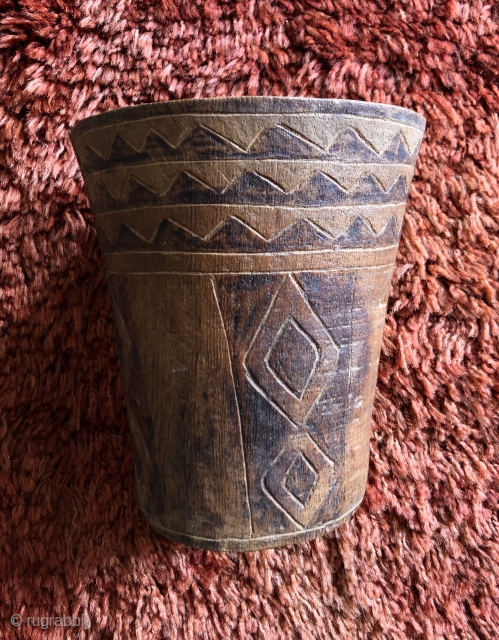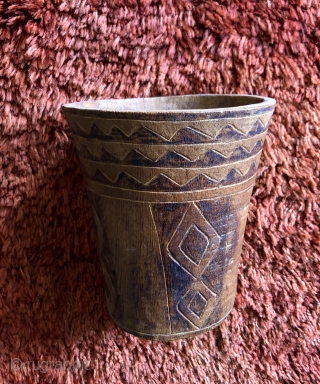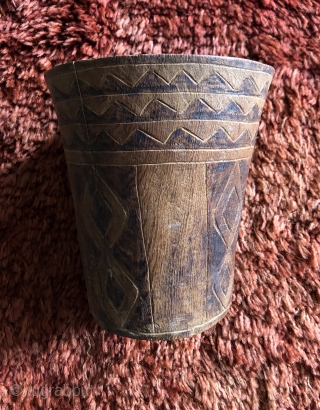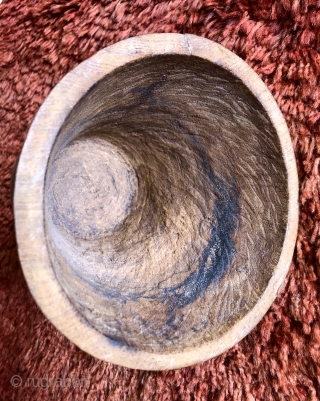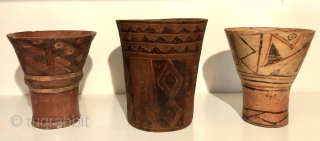Back
Large, incised ceremonial drinking vessel (Kero). Incan period, highlands of Bolivia. Keros came into use around a.d. 400 - 500 during the Tiwanaku period and where used there after in many areas of the Andean region for drinking a fermented beer-like beverage known as Chicha. Corn was the main and most coveted ingredient in chicha, but it can be made from other grains or plants. In the high Andes corn was not grown and so had to be imported from lower altitude valleys making it a precious commodity. Ceremonial and ritual drinking and feasting was a highly important activity for the indigenous Andean peoples from very early times. It was used to cement social and work relationships and was essential for the well being of the community and the State. This kero was incised and burned in areas to create the design of simple diamond forms and saw-tooth borders. This is an unusual method for such vessels as incising in wood was the main way these were decorated. It was made from one block of very hard wood. It is likely an Incan period carving, though it is not classic Incan, but rather a provincial version of the classic Incan incised keros. Keros were most often commonly made in ceramic,(see image of two Tiwanaku period Keros for comparison) but can also be carved from stone and wood. Imperial Incan keros were sometimes made from gold or silver as well, but more commonly wood. Size: 7 inches high x 6.5 inches in diameter.
price:
inquire
- Home
- Antique Rugs by Region
- Category
- Profiles
- Post Items Free
- Albums
- Benaki Museum of Islamic Art
- Budapest: Ottoman Carpets
- Gulbenkian Museum
- Islamic Carpets. Brooklyn
- Islamic Textiles. Brooklyn
- Konya Museum: Rugs
- MKG, Hamburg
- MMA: Caucasian Carpets
- MMA: Mamluk Carpets
- MMA: Mughal Indian Carpets
- MMA: Ottoman Carpets
- MMA: Safavid Persian Carpets
- MMA: Turkmen Rugs
- McCoy Jones Kilims
- Ottoman textiles. Met
- Philadelphia Museum
- Rugs and Carpets: Berlin
- Seljuqs at the Met
- TIEM, Istanbul: Carpets
- V&A: Classical Carpets
- Vakiflar Carpets: Istanbul
- Baluch Rugs: Indianapolis
- Gallery Exhibitions
- Jaf an Exhibition
- Alberto Levi Gallery
- Andean Textile
- Christie's London: 2016
- Francesca Galloway
- HALI at 40
- ICOC Washington, DC 2018
- Jajims of the Shahsavan
- London Islamic Week April, 2018
- Mongolian Felts
- Navajo Rugs: JB Moore
- Persian Piled Weavings
- SF Tribal & Textile Art Show 2020
- SF Tribal 2019
- Sotheby's: C. Alexander
- Turkish Prayer Rugs
- Turkmen Main Carpets ICOC 2007










